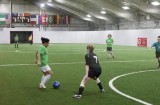-
Recent Posts
Smithsonian Calendar
June 2025 M T W T F S S 1 2 3 4 5 6 7 8 9 10 11 12 13 14 15 16 17 18 19 20 21 22 23 24 25 26 27 28 29 30 Archives
1113 Kingsbury Drive,
Chesapeake VA 23322diagonalrun@hotmail.com
- Home
- About Us
- Programs
- Philosophy
- Testimonials
The Benefits of Winter Training When Compared to Indoor Soccer
I get asked the question of whether indoor soccer is as beneficial as a comprehensive technical training program all the time. I will attempt to answer this question in a succinct manner. It is our opinion at Smithsonian Soccer Academy that an intense, professional and comprehensive soccer training program is vastly superior to playing indoor soccer for the reasons listed below:
1. Touches!
A player participating in an indoor soccer match, if they play the entire match, will receive a couple hundred touches of the soccer ball at best. A player attending a typical Smithsonian Soccer Academy Training session will receive between 1,500-4,000 touches in a session. In addition, these touches will be dynamic and always involve time, space, and opponent pressure.2. Coachable Moments
Because of the multitude of field shapes, opponent locations, time restrictions, touch restrictions, and and space limitations, the number of coachable moments increase. This means that a player is constantly exposed to circumstances that will require nearly a perfect touch and tactical insight.3. Technical Variety
Player’s are exposed to technical training that emphasizes dribble moves, Coerver ball handling skills (quick feet), short range passing, long-ball service, heading, volley sequences, and finishing with different surfaces. Smithsonian Soccer Academy players significantly increase their speed of play through participation in demanding passing and receiving exercises. You will not receive this technical variety by playing indoor soccer. Smithsonian players are taught from a very young age to pass and receive efficiently while under opponent pressure, time constraints, and playing in limited space. This is the hallmark of Smithsonian Soccer Academy training sessions. All Smithsonian soccer players will be taught to play quickly, play on the move, and be able to adapt to severe opponent pressure in a training environment that limits time and space.4. Tactical Insight
Smithsonian participants are constantly being taught how to anticipate play, awareness of where the ball, where teammates and opponents are located, and seeing the entire field with proper body shape. Being able to anticipate what is going to happen, being aware, maintaining an open body shape, and then being able to execute technically are the hallmarks of a great soccer player. You have minimal ability to train these vitally important characteristics during an indoor soccer match.5. Physical Training:
Every Smithsonian Soccer Academy training session will have a speed, strength, quickness, and power component. In addition, players can participate in an anaerobic and aerobic fitness program for 30 minutes after the Saturday morning session and 30 minutes before the Sunday afternoon sessions. Our program provides a fitness base that indoor soccer cannot provide.6. 1V1 Confrontations:
Every Smithsonian Soccer Academy training session will involve hundreds of 1v1 confrontations, or as we like to call it, 1v1 opportunities. Players will develop the mental confidence and technical ability to seek out 1v1 opportunities and take great pride in going at a defender with the ball at their feet. Our training environment absolutely thrives on teaching the skills and helping players gain the confidence to execute these skills in a non-threatening and encouraging training program.7. Positive Training Environment:
Where Players are Developed, Rather than a Game Environment Where Playing For Results Inhibits Technical Development
Soccer training at the youth level MUST be positive. If your training environment is positive youth players will train harder and become much more effective soccer players. With positive coaching, we can develop confident, thinking, and creative soccer players who will experiment on the field to do amazing things. Indoor soccer is often times an extension of the outdoor game where parents and coaches emphasize winning and play in a manner that absolutely hinders player development. Players are afraid to make mistakes, do not experiment, and end up playing without skill and technical flair. Smithsonian Soccer Academy concentrates totally on developing players, encouraging players to take chances, and helping players to mentally seek challenges where they may fail, but will be positively encouraged to try again.Smithsonian Soccer Academy encourages players to play indoor soccer for fun, but unequivocally believes that playing a few indoor games over the winter will not develop the technical, tactical, mental, and physical abilities that are required to develop as a soccer player. We attempt to perform exercises that engage the brain, require constant scanning of the field, emphasizes movement in different directions, and receiving and passing on the move. We demand technical excellence in an environment where the brain is receiving multiple impulses and conflicting information. This training leads to tremendous increases in speed of play where players must perform in tight spaces under severe opponent pressure. Register today for the Smithsonian Soccer Academy Winter Training Program if you want to improve your technical ability and decision making on the soccer field.
Thanks,
Kevin Smith
Technical Director
Smithsonian Soccer Academy


